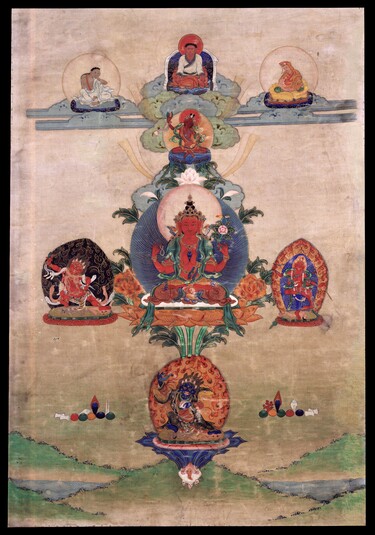
Item: Avalokiteshvara (Bodhisattva & Buddhist Deity) - Jinasagara (Ocean of Conquerors, Four Arms)
| Origin Location | Eastern Tibet |
|---|---|
| Date Range | 1800 - 1899 |
| Lineages | Karma (Kagyu) and Buddhist |
| Material | Ground Mineral Pigment on Cotton |
| Collection | Rubin Museum of Art |
| Catalogue # | acc.# P1996.29.1 |
| Painting School | Palpung / Situ |
Alternate Names: Lokeshvara Avalokita Lokanata Lokanatha Mahakarunika
Classification: Deity
Appearance: Peaceful
Gender: Male
Jinasagara Avalokiteshvara, Five Deities (Tibetan: chen re zi, gyal wa gya tso. English: the All Seeing Lord, Ocean of Conquerors): the depiction of a meditation practice focused on five figures. There are many different forms of Jinasagara along with mandalas of varying size and numbers of retinue figures. (See HAR #790).
At the center of the composition is (1) Jinasagara Avalokiteshvara. At the left side (right of Jinasagara) is a wrathful red (2) Hayagriva. On the right side is a four-armed orange (3) Guhya Jnana Dakini. Above Jinasagara is (4) Siddhirajni, an Indian female Tantric siddha, representing the lineage (usually Padmasambhava is depicted). Below the central Jinasagara is (5) Bernagchen Mahakala.
The five figures represent the (1) Ishtadevata (meditational deity) placed at the center. Representing wrathful deities is (2) Hayagriva on the proper right side of the Jinasagara. Representing the Dakinis is (3) Guhya Jnana on the left side. Representing the lineage Gurus is (4) Siddhirajni placed above. Representing the protectors is (5) Bernagchen placed below. Although appearing in the painting as a vertical hierarchy the five deity figures are understood to be present on a horizontal flat plane with only the Machig figure placed in the sky directly above the head of Jinasagara.
At the top center of the painting is Marpa Lotsawa Chokyi Lodro. On the left is Milarepa and on the right Gampopa. These three Tibetan teachers form the earliest lineage and formation of the Marpa Kagyu Tradition of Tibetan Buddhism. They however are not part of the lineage of the Jinasagara Avalokiteshvara which became popular in the Karma Kagyu Tradition of Tibet at the time of the 2nd Karmapa. Their presence in the composition establishes the over-all religious and iconographic program of the painting which is Karma Kagyu.
Lineage: Dharmakaya Amitabha, Sambhogakaya Avalokiteshvara, Nirmanakaya Padmasambhava, Siddhirajni (Machig Drupa'i Gyalmo), Tebu Drime Shenyen, Rechung Dorje Drag, Lama Zangri Repa, Drogon Repa Chenpo, Gyalse Punya Vajra, Drubchen Karma Pakshi - the 2nd Karmapa, etc.
Jeff Watt 4-2001 [updated 8-2010]
Subject: Krishnasara (Antelope)
Tradition: Kagyu Deity Paintings
Collection of Rubin Museum of Art: Painting Gallery 7
Buddhist Deity: Avalokiteshvara, Jinasagara (Five Deity, Rechung),
Buddhist Deity: Avalokiteshvara Main Page
Painting Style: Kham Region (Kham-ri)
Buddhist Deity: Avalokiteshvara, Jinasagara (Rechung)
Collection of Rubin Museum of Art: Avalokita (Painting)
Painting Style: Palpung - Peaceful & Semi-Peaceful Deities
Buddhist Deity: Avalokiteshvara, Jinasagara, Main Page



